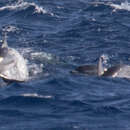Diagnostic Description
provided by FAO species catalogs
The clymene dolphin is externally similar to the spinner dolphin, but is smaller and more robust, with a much shorter and stockier beak. The dorsal fin is slightly more falcate, as opposed to the often very triangular dorsal fins of spinner dolphins. Despite these external similarities with the spinner dolphin, skull morphology indicates that the clymene dolphin may be closely related to the striped dolphin. A three-part colour pattern, with a dark grey cape, light grey sides, and white belly, is characteristic of this species. The cape dips in 2 places, above the eye, and below the dorsal fin. The beak is mostly light grey, but the lips and beak tip are black. There is also a dark stripe on the top of the beak, from the tip to the apex of the melon, and often a dark "moustache" marking on the middle of the top of the beak. The eye is also surrounded by black, and a dark grey stripe runs from the eye to the flipper. Tooth counts are generally much lower than in spinner dolphins: 38 to 49 teeth per row. They are slender and pointed. Can be confused with: Clymene dolphins are most easily confused with spinner dolphins, but are more robust, with shorter stubbier beaks. Also, the colour pattern is slightly different; the 2 dips in the cape and the dark line (and often a "moustache") on top of the beak will allow clymene dolphins to be distinguished. The body shape of clymene dolphins also closely resembles that of short-beaked (offshore) forms of the common dolphin , as does the colour pattern in a superficial way. Common dolphins can best be distinguished by their hourglass pattern, cape that forms a V below the dorsal fin, chin-to-flipper stripe, and absence of a "moustache".
- bibliographic citation
- Marine mammals of the world. Jefferson, T.A., S. Leatherwood & M.A. Webber - 1993. FAO species identification guide. Rome, FAO. 320 p. 587 figs. .
- author
- Food and Agriculture Organization of the UN
Size
provided by FAO species catalogs
So far, clymene dolphins are known to reach at least 2.0 m in length and sexual maturity is reached by about 1.8 m. Newborn length is unknown, but is less than 1.2 m. This species reaches weights of at least 85 kg.
- bibliographic citation
- Marine mammals of the world. Jefferson, T.A., S. Leatherwood & M.A. Webber - 1993. FAO species identification guide. Rome, FAO. 320 p. 587 figs. .
- author
- Food and Agriculture Organization of the UN
Brief Summary
provided by FAO species catalogs
Very little is known of the clymene dolphin's natural history. Schools tend to be much smaller than those of spinner dolphins (generally less than 50 animals). They are known to associate with other species of dolphins. These quick and agile dolphins ride bow waves, and have been reported to spin on the long axis.Clymene dolphins feed on small fish and squid at moderate depths, presumably mainly at night.
- bibliographic citation
- Marine mammals of the world. Jefferson, T.A., S. Leatherwood & M.A. Webber - 1993. FAO species identification guide. Rome, FAO. 320 p. 587 figs. .
- author
- Food and Agriculture Organization of the UN
Benefits
provided by FAO species catalogs
In the Caribbean, clymene dolphins appear, at least occasionally, to be taken in the Lesser Antilles small cetacean fishery, and in gillnets. They may be one of the species taken in tuna purse seines in the eastern tropical Atlantic. IUCN: Insufficiently known.
- bibliographic citation
- Marine mammals of the world. Jefferson, T.A., S. Leatherwood & M.A. Webber - 1993. FAO species identification guide. Rome, FAO. 320 p. 587 figs. .
- author
- Food and Agriculture Organization of the UN

